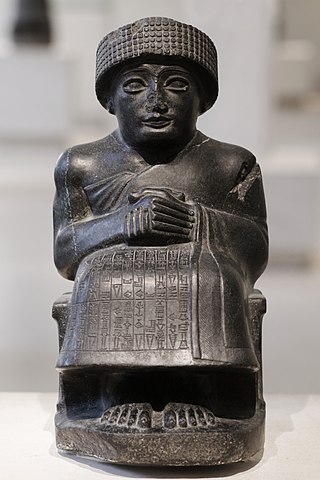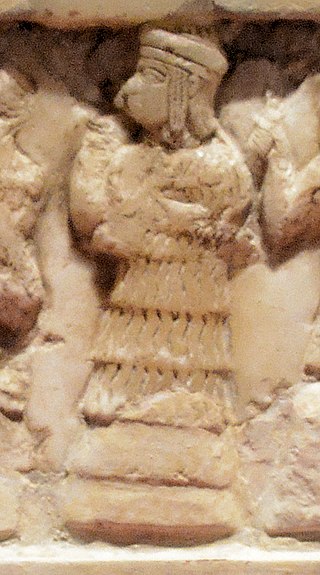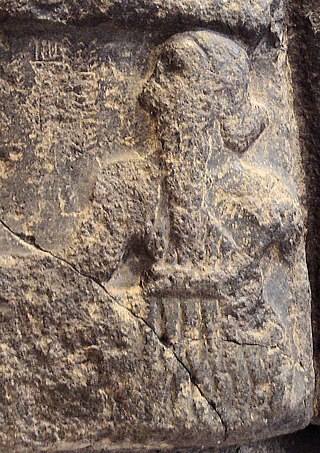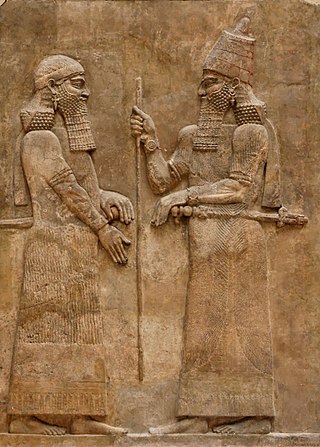External links
| Regnal titles | ||
|---|---|---|
| Preceded by | King of Kish ca. 2300 BC | Succeeded by |
Ur-Zababa | |
|---|---|
| Title | King of Sumer |
| Parent | Puzur-Suen |
| Relatives | Kubaba (grandmother) |
Ur-Zababa is listed on the Sumerian King List as the second king of the 4th Dynasty of Kish. This text also records that Ur-Zababa had appointed Sargon of Akkad as his cup-bearer. Sargon was later the ruler of the Akkadian Empire.
According to the King List, Ur-Zababa was a son of King Puzur-Suen. His mother is unknown. [1] [2] His grandmother was the famous Queen Kubaba.
The Sargon legend is a Sumerian text purporting to be Sargon's biography. In the text, Ur-Zababa is mentioned, who awakens after a dream. For unknown reasons, Ur-Zababa appoints Sargon as a cupbearer. Soon after this, Ur-Zababa invites Sargon to his chambers to discuss a dream of Sargon's, involving the favor of the goddess Inanna. Ur-Zababa was deeply frightened. In an attempt to kill him, Ur-Zababa sends an unwitting Sargon to deliver his bronze mirror to the E-sikil, where the chief smith, Belic-tikal, will receive it. Ur-Zababa instructed the smith to throw Sargon and the mirror into the statue molds upon arrival. However, on his way to the E-sikil the goddess Inanna instructs Sargon to not enter into the E-sikil, but only meet Belic-tikal at the gate of the E-sikil. This ruins Belic-tikal's chance to kill Sargon, and five to ten days later Sargon reappears in the courts of Ur-Zababa.
When Sargon returns to Ur-Zababa, the king becomes frightened again, and decides to send Sargon to Lugal-zage-si of Uruk, with a message on a clay tablet asking him to slay Sargon. [3] [4]
The Weidner Chronicle (ABC 19) agrees with both the King List and the Sargon Legend in making Sargon the cupbearer to Ur-Zababa, mentioning him in a single line as ruling in between Kubaba (Kugbau) and Sargon.
It goes on to say that Sargon failed to comply fully with this order, and though he became king, he was eventually punished by the Sumerian deities for his improper observances. [5]
Most copies of the King List give Ur-Zababa an unrealistic reign of 400 years, but one copy reading "six years" is held to be more plausible.[ citation needed ]
It is known that Lugal-zaggesi of Uruk and Umma destroyed Kish toward the end of his reign, before himself being deposed by Sargon. It is often assumed that Sargon also played a role in Ur-Zababa's downfall, but the relevant texts are too fragmentary to be explicit.
Ur-Zababa's successors in Kish as named on the king-list, beginning with Zimudar, seem to have been vassals of Sargon, and there is no evidence that they ever really exercised hegemony in Sumer. [6]

The Akkadian Empire was the first ancient empire of Mesopotamia, succeeding the long-lived civilization of Sumer. Centered on the city of Akkad and its surrounding region, the empire would unite Akkadian and Sumerian speakers under one rule and exercised significant influence across Mesopotamia, the Levant, and Anatolia, sending military expeditions as far south as Dilmun and Magan in the Arabian Peninsula.

The Sumerian King List or Chronicle of the One Monarchy is an ancient literary composition written in Sumerian that was likely created and redacted to legitimize the claims to power of various city-states and kingdoms in southern Mesopotamia during the late third and early second millennium BC. It does so by repetitively listing Sumerian cities, the kings that ruled there, and the lengths of their reigns. Especially in the early part of the list, these reigns often span thousands of years. In the oldest known version, dated to the Ur III period but probably based on Akkadian source material, the SKL reflected a more linear transition of power from Kish, the first city to receive kingship, to Akkad. In later versions from the Old Babylonian period, the list consisted of a large number of cities between which kingship was transferred, reflecting a more cyclical view of how kingship came to a city, only to be inevitably replaced by the next. In its best-known and best-preserved version, as recorded on the Weld-Blundell Prism, the SKL begins with a number of antediluvian kings, who ruled before a flood swept over the land, after which kingship went to Kish. It ends with a dynasty from Isin, which is well-known from other contemporary sources.

Inanna is the ancient Mesopotamian goddess of love, war, and fertility. She is also associated with beauty, sex, divine law, and political power. Originally worshiped in Sumer, she was known by the Akkadian Empire, Babylonians, and Assyrians as Ishtar. Her primary title was "the Queen of Heaven".

The history of Sumer spans the 5th to 3rd millennia BCE in southern Mesopotamia, and is taken to include the prehistoric Ubaid and Uruk periods. Sumer was the region's earliest known civilization and ended with the downfall of the Third Dynasty of Ur around 2004 BCE. It was followed by a transitional period of Amorite states before the rise of Babylonia in the 18th century BCE.

Enheduanna was the entu (high) priestess of the moon god Nanna (Sīn) in the Sumerian city-state of Ur in the reign of her father, Sargon of Akkad. She was likely appointed by her father as the leader of the religious group at Ur to cement ties between the Akkadian religion of her father and the native Sumerian religion.

Adab or Udab was an ancient Sumerian city between Girsu and Nippur. It was located at the site of modern Bismaya or Bismya in the Wasit Province of Iraq. The city-god of Adab was Parag'ellilegarra (Panigingarra) "The Sovereign Appointed by Ellil".

The Gutian dynasty was a line of kings, originating among the Gutian people. Originally thought to be a horde that swept in and brought down Akkadian and Sumerian rule in Mesopotamia, the Gutians are now known to have been in the area for at least a century by then. By the end of the Akkadian period, the Sumerian city of Adab was occupied by the Gutians, who made it their capital. The Gutian Dynasty came to power in Mesopotamia near the end of the 3rd Millennium BC, after the decline and fall of the Akkadian Empire. How long Gutian kings held rulership over Mesopotamia is uncertain, with estimates ranging from a few years up to a century. The end of the Gutian dynasty is marked by the accession of Uruk ruler Utu-hengal, marking the short lived "Fifth dynasty of Uruk", followed by Ur ruler Ur-Nammu, founder of the Third Dynasty of Ur.

Lugal-Zage-Si of Umma was the last Sumerian king before the conquest of Sumer by Sargon of Akkad and the rise of the Akkadian Empire, and was considered as the only king of the third dynasty of Uruk, according to the Sumerian King List. Initially, as king of Umma, he led the final victory of Umma in the generation-long conflict with the city-state Lagash for the fertile plain of Gu-Edin. Following up on this success, he then united Sumer briefly as a single kingdom.
Kubaba was a legendary Mesopotamian queen who according to the Sumerian King List ruled over Kish for a hundred years before the rise of the dynasty of Akshak. It is typically assumed that she was not a historical figure.
Bad-tibira, "Wall of the Copper Worker(s)", or "Fortress of the Smiths", identified as modern Tell al-Madineh, between Ash Shatrah and Tell as-Senkereh and 33 kilometers northeast of ancient Girsu in southern Iraq, was an ancient Sumerian city on the Iturungal canal, which appears among antediluvian cities in the Sumerian King List. Its Akkadian name was Dûr-gurgurri. It was also called Παντιβίβλος (Pantibiblos) by Greek authors such as Berossus, transmitted by Abydenus and Apollodorus. This may reflect another version of the city's name, Patibira, "Canal of the Smiths".
Zababa was the tutelary deity of the city of Kish in ancient Mesopotamia. He was a war god. While he was regarded as similar to Ninurta and Nergal, he was never fully conflated with them. His worship is attested from between the Early Dynastic to the Achaemenid periods, with the Old Babylonian kings being particularly devoted to him. Starting with the Old Babylonian period, he was regarded as married to the goddess Bau.

Enmerkar was an ancient Sumerian ruler to whom the construction of the city of Uruk and a 420-year reign was attributed. According to literary sources, he led various campaigns against the land of Aratta.

Nanaya was a Mesopotamian goddess of love, closely associated with Inanna.

Ninshubur, also spelled Ninšubura, was a Mesopotamian goddess whose primary role was that of the sukkal of the goddess Inanna. While it is agreed that in this context Ninshubur was regarded as female, in other cases the deity was considered male, possibly due to syncretism with other divine messengers, such as Ilabrat. No certain information about her genealogy is present in any known sources, and she was typically regarded as unmarried. As a sukkal, she functioned both as a messenger deity and as an intercessor between other members of the pantheon and human petitioners.

É is the Sumerian word or symbol for house or temple.

Sargon of Akkad, also known as Sargon the Great, was the first ruler of the Akkadian Empire, known for his conquests of the Sumerian city-states in the 24th to 23rd centuries BC. He is sometimes identified as the first person in recorded history to rule over an empire.

Uhub, , was Ensi (Governor) of the Sumerian city-state of Kish before Mesilim

King of the Universe, also interpreted as King of Everything, King of the Totality, King of All or King of the World, was a title of great prestige claiming world domination used by powerful monarchs in ancient Mesopotamia. The title is sometimes applied to God in the Judeo-Christian and Abrahamic tradition.

Lugal-kinishe-dudu also Lugal-kiginne-dudu , was a King and (ensi) of Uruk and Ur who lived towards the end of the 25th century BCE. The Sumerian King List mentions Lugal-kinishe-dudu as the second king of the dynasty after En-shakansha-ana, attributing to him a fanciful reign of 120 years.

Lugal-kisalsi, also Lugaltarsi was a King of Uruk and Ur who lived towards the end of the 25th century BCE, succeeding his father Lugal-kinishe-dudu, according to contemporary inscriptions, although he does not appear in the Sumerian King List. In one of his inscriptions, he appears as "Lugalkisalsi, the first-born son of Lugalkigenedudu, king of Uruk and Ur".